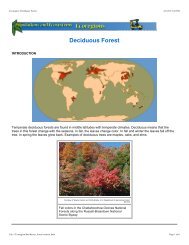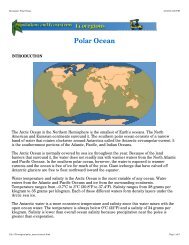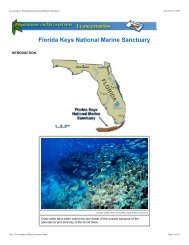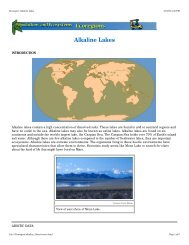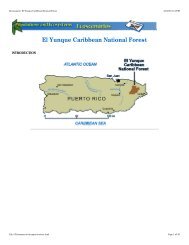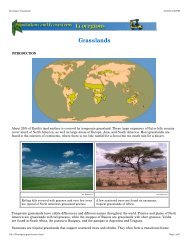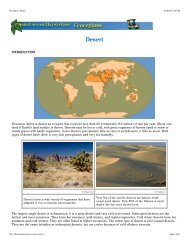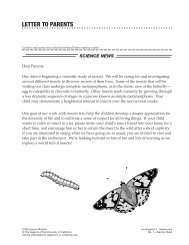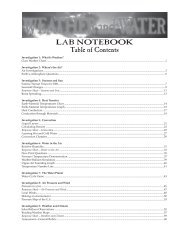Ecoscenarios Combined - FOSSweb
Ecoscenarios Combined - FOSSweb
Ecoscenarios Combined - FOSSweb
Create successful ePaper yourself
Turn your PDF publications into a flip-book with our unique Google optimized e-Paper software.
Ecoscenario: Arctic National Wildlife Refuge<br />
4/16/03 3:07 PM<br />
Other animals found on the tundra include arctic foxes, snowshoe hares, lemmings, snow geese, and snowy owls.<br />
Many species of migratory birds nest on the marshy tundra during the short summer, leaving in fall to spend winter<br />
in warmer areas.<br />
Animals living on the tundra have adaptations to keep them warm. Weasels, rabbits, hares, and musk ox have two<br />
layers of hair, a soft, short layer close to the skin and a coarser, longer layer of guard hairs. Both layers work to<br />
keep warm air near the body and cold air and snow away. Some animals also have small ears, short legs, and<br />
short tails, which help reduce heat loss.<br />
Caribou have long, dense winter coats with hollow hairs for effective insulation. Both males and females have<br />
antlers, which are covered with velvet and fed by many blood vessels as they grow. Large concave hooves help<br />
caribou paw through the snow to reach buried lichens. Their broad hooves act like snowshoes and help them cross<br />
snow in winter and walk through soft, boggy pools in summer.<br />
Courtesy of U.S. Fish and Wildlife Service<br />
The huge Porcupine Herd migrating across the tundra of the Arctic National Wildlife Refuge.<br />
Caribou migrate in huge herds from their wintering grounds in the Brooks Range taiga to calving grounds on the<br />
coastal plain over 640 kilometers (400 miles) away. They return yearly to the same calving grounds because there<br />
are few predators and high-quality food is abundant. Calving occurs during a 10 days in late May to early June. At<br />
this time, cows and calves are most vulnerable to predators and sensitive to any disturbances.<br />
Musk ox have roamed in the arctic since the Ice Age. They are well adapted for living on the tundra. To keep warm,<br />
they have a long, shaggy coat of guard hairs with shorter underfur that is extremely soft and fine. It can protect the<br />
musk ox in temperatures as low as –73ºC (–100ºF). The underfur, or wool (called qiviut), is shed in summer and<br />
collected by Alaskan natives to make woolen clothing.<br />
Musk ox travel in herds of 20–30 animals. When attacked by wolves, the larger adults form a circle with their horns<br />
facing outward. Young musk ox are protected in the middle of this circle. Extremely efficient at processing food,<br />
they need only one-sixth the food a similar-sized cow would use. In seasons when food is especially poor, they<br />
may wander into the wolves' range in search of food.<br />
file:///Ecoscenario/arctic/content.html<br />
Page 7 of 13



